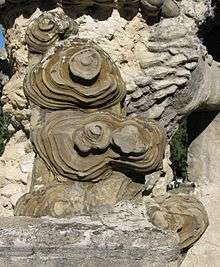Ferdinand Cheval

Ferdinand Cheval (19 April 1836 – 19 August 1924) was a French postman who spent thirty-three years of his life building Le Palais idéal (the "Ideal Palace") in Hauterives.[1][2] The Palace is regarded as an extraordinary example of naïve art architecture.
Origins
Ferdinand Cheval was born in Charmes-sur-l'Herbasse, in the Drôme département of France, and lived in Châteauneuf-de-Galaure. He left school at the age of 13 to become a baker's apprentice, but eventually became a postman.[1][2]
Palais idéal

Cheval began the building in April 1879. He reported:
I was walking very fast when my foot caught on something that sent me stumbling a few meters away, I wanted to know the cause. In a dream I had built a palace, a castle or caves, I cannot express it well... I told no one about it for fear of being ridiculed and I felt ridiculous myself. Then fifteen years later, when I had almost forgotten my dream, when I wasn't thinking of it at all, my foot reminded me of it. My foot tripped on a stone that almost made me fall. I wanted to know what it was... It was a stone of such a strange shape that I put it in my pocket to admire it at my ease. The next day, I went back to the same place. I found more stones, even more beautiful, I gathered them together on the spot and was overcome with delight... It's a sandstone shaped by water and hardened by the power of time. It becomes as hard as pebbles. It represents a sculpture so strange that it is impossible for man to imitate, it represents any kind of animal, any kind of caricature.I said to myself: since Nature is willing to do the sculpture, I will do the masonry and the architecture"[3][4]
For the next thirty-three years, Cheval picked up stones during his daily mail round and carried them home to build the Palais idéal.[1] He spent the first twenty years building the outer walls. At first, he carried the stones in his pockets, then switched to a basket. Eventually, he used a wheelbarrow. He often worked at night, by the light of an oil lamp.[1][2]
The Palais is a mix of different styles with inspirations from Christianity to Hinduism. Cheval bound the stones together with lime, mortar and cement.[1][2]
Burial
Cheval wanted to be buried in his palace. Because that is illegal in France, he spent eight more years building a mausoleum for himself in the Hauterives cemetery. He died on 19 August 1924, about a year after he had finished building it, and is buried there.[1][2]
Recognition
Just before his death, Cheval began to receive some recognition from luminaries like André Breton and Pablo Picasso. His work is commemorated in an essay by Anaïs Nin. In 1932, the German artist Max Ernst created a collage titled The Postman Cheval. The work belongs to the Peggy Guggenheim Collection and is on display there. In 1958, Ado Kyrou produced Le Palais idéal, a short film about Cheval's palace.
In 1969, André Malraux, the Minister of Culture, declared the Palais a cultural landmark and had it officially protected.[2] In 1986 Cheval was put on a French postage stamp.[2]
Visiting hours
It is open for visitors every day except Christmas Day, New Year's Day and 15 to 31 January.
Gallery
- Palais idéal
 Hindu temple
Hindu temple Detail of north front
Detail of north front Swiss chalet
Swiss chalet
See also
References
- 1 2 3 4 5 6 Palais Idéal: The postman’s palace, Interesting Thing of the Day, 15 August 2007.
- 1 2 3 4 5 6 7 Mary Blum. "The postman who delivered a palace", New York Times, 3 May 2007
- ↑ Becker, Howard S. Art Worlds. University of California Press (1982), pp. 263–64.
- ↑ Pierre Chazaud, op. cit. (translated from French)
External links
| Wikimedia Commons has media related to Ferdinand Cheval. |
- Postman Cheval's website in English and French
- Le Palais Idéal du Facteur Cheval (requires Flash).
- Expo.htm at perso.wanadoo.fr" Expo Coco Peintre du Facteur Cheval-1987 Hauterives France
- Hauterives and Palais Idéal Photogallery
- Album Mon Cheval, a French blog's photogallery.
Coordinates: 45°15′23″N 5°1′43″E / 45.25639°N 5.02861°E